Best Alternatives to Influencity
Passionate content and search marketer aiming to bring great products front and center. When not hunched over my keyboard, you will find me in a city running a race, cycling or simply enjoying my life with a book in hand.

Influencity is a popular platform for managing influencer campaigns, but it’s not the only option. If you need faster content, better UGC support, or a simpler workflow, there are other tools that might fit better.
And here’s why that matters: 93% of marketers say UGC outperforms branded content. If you’re not building content that feels real and relatable, you’re probably getting scrolled past.
This guide breaks down the best Influencity alternatives, so you can find one that actually fits your goals.
TL;DR
Not ready to dive into a long article? Here’s the summary of the best Influencity alternatives.
- Influencity is solid for managing influencer campaigns
- Influencity is not great for quick, scalable content or UGC
- Influencity alternatives offer different strengths for different budgets
- Billo is built as a full creator marketing channel – from creation to iteration.

What is Influencity?
Influencity is an influencer marketing platform built to help brands find creators, manage campaigns, and track results. It’s packed with features, like detailed audience insights, customizable workflows, and performance analytics.
If you’re running influencer programs at scale, it checks a lot of boxes. But it’s built for teams who already know what they’re doing and have time to manage multiple moving parts.
- Content type: Traditional influencer content, think feed posts, stories, partnerships. No UGC creation tools.
- Ideal customer: Agencies and brands with in-house influencer managers.
- Data analysis: Strong. Detailed dashboards, engagement stats, and ROI tracking.
- Customization: Decent flexibility, but designed more for structure than speed.
- Creator database size: Over 170 million influencer profiles across major platforms.
If your strategy revolves around influencer reach and campaign tracking, Influencity delivers. But if you’re looking for real people using your product on camera, or scalable video for ads, you may need a more UGC-focused alternative.
Reviews G2 and Capterra say the tools are powerful, but can feel complex and pricey, especially if you just need content, fast.
Top Influencity Alternatives
Influencity isn’t a one-size-fits-all platform. If you need faster content, easier workflows, or better UGC support, there are other options worth exploring.
Here’s how the top Influencity alternatives stack up and who they’re really built for.
1. HypeAuditor
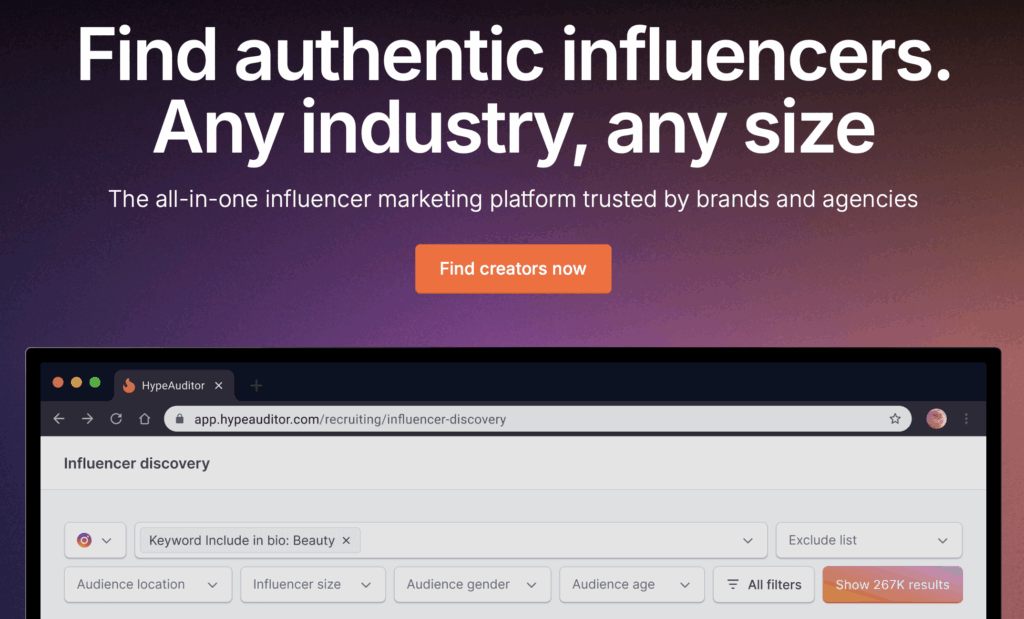
HypeAuditor focuses on influencer discovery and performance analytics. It’s known for its fraud detection and audience credibility scoring, which makes it popular with brands concerned about fake followers and inflated engagement.
Compared to Influencity, HypeAuditor leans more into data and less into campaign management. You won’t get the same built-in workflow tools or creator messaging features, but you will get powerful audience analysis.
- Content type: Influencer-first. No UGC tools or video creation features.
- Ideal customer: Agencies or data-driven teams that run influencer audits.
- Data analysis: Strong. Audience credibility, reach forecasting, and market benchmarking.
- Customization: Limited. It’s more about evaluating creators than managing them.
- Creator database size: Broad, but built around analytics, not campaign execution.
If you’re running influencer due diligence at scale, HypeAuditor is useful. But if you’re after creative flexibility or ready-to-use content, Influencity, or one of the other platforms below, offers more hands-on tools.
2. Upfluence
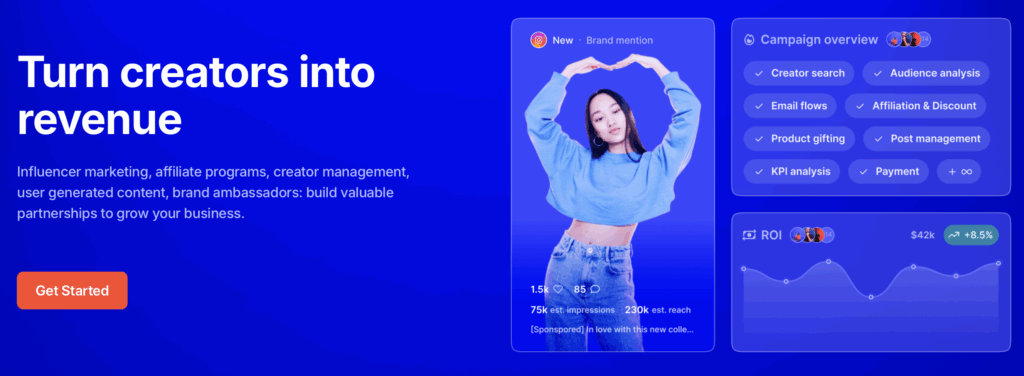
Upfluence is a full-service influencer marketing platform with strong CRM features and deep audience filters. It’s built for brands that want to manage long-term influencer partnerships and understand who they’re reaching, down to niche audience segments.
Where Upfluence stands out is in its integration with eCommerce tools like Shopify and WooCommerce. You can invite existing customers to become brand advocates and track sales through affiliate codes.
- Content type: Traditional influencer content. UGC support is limited.
- Ideal customer: Mid-sized to large brands with in-house marketing teams.
- Data analysis: Advanced filtering, purchase tracking, and ROI insights.
- Customization: Campaign workflows are flexible, but better suited for long-term collaborations.
- Creator database size: Large, with strong filtering by engagement, industry, and audience type.
Compared to Influencity, Upfluence offers similar reach and reporting, but edges ahead in eCommerce integration. If you’re looking for influencer discovery and affiliate tracking, but not fast UGC, this might be a better fit.
3. GRIN
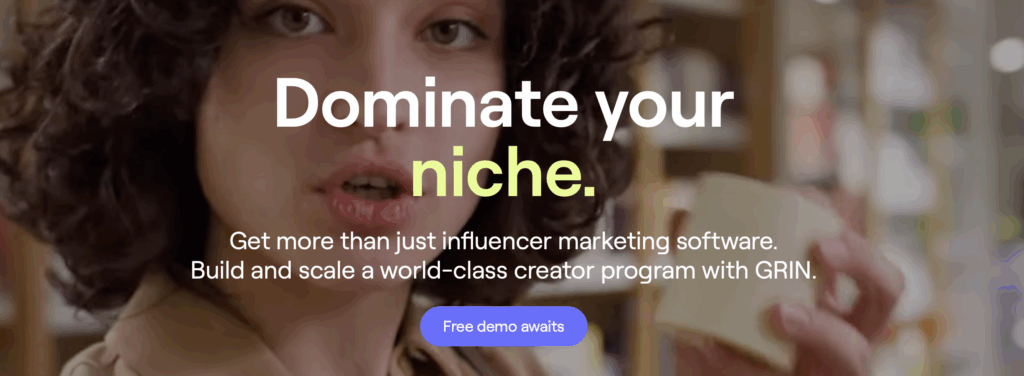
GRIN is built for eCommerce brands that want full control over influencer relationships, especially when it comes to seeding products, running affiliate programs, and tracking performance from click to sale. It integrates directly with platforms like Shopify and WooCommerce, making it a solid choice for DTC teams.
Unlike Influencity, GRIN focuses more on relationship management than discovery. You’ll need to bring your own influencers or import them through integrations.
- Content type: Long-term influencer campaigns, ambassador programs. Not focused on one-off UGC.
- Ideal customer: DTC brands with strong eCommerce infrastructure.
- Data analysis: Good for conversion tracking, especially for affiliate or gifting workflows.
- Customization: High. Campaigns are built to fit your internal processes.
- Creator database size: No native discovery, depends on your own network.
If your team is already managing influencers and needs backend support, GRIN works well. But for short-form content or fast video creation, it’s not the right tool.
4. CreatorIQ

CreatorIQ is an enterprise-grade platform used by global brands to manage influencer programs at scale. It offers deep integrations with major ad platforms, built-in compliance tools, and extensive analytics. It’s ideal if you need a robust system to handle complex campaigns across multiple regions.
Compared to Influencity, CreatorIQ is more advanced but also more expensive. It’s not built for speed or simplicity, it’s designed for scale.
- Content type: Long-term influencer partnerships, large-scale brand activations. No UGC production tools.
- Ideal customer: Global enterprises with large budgets and dedicated teams.
- Data analysis: Enterprise-level, with customizable dashboards and attribution tracking.
- Customization: Very high. Great for advanced workflows and team collaboration.
- Creator database size: One of the largest in the industry, with verified profiles across all major platforms.
If your brand needs global control and detailed compliance, CreatorIQ delivers. But for agile content creation or small-scale UGC, it’s far more than most teams need.
5. Modash

Modash is a lean, discovery-focused platform built for teams that want to plug influencer data into their own systems. It’s API-friendly, with fast search and strong filtering, but it doesn’t offer campaign management or built-in content tools.
Compared to Influencity, Modash is lighter and more modular. You won’t find messaging tools or full campaign workflows, but if you’re a developer or growth team building something custom, that might be exactly what you want.
- Content type: Discovery only. No UGC tools, influencer messaging, or production workflows.
- Ideal customer: Tech-savvy startups or teams building internal systems.
- Data analysis: Strong filtering, real-time follower insights. Lacks performance reporting.
- Customization: High, if you’re building your own setup. Low, if you need ready-made features.
- Creator database size: Covers Instagram, TikTok, and YouTube globally.
If you want fast, accurate influencer data and don’t need the rest, Modash is a clean, no-frills option. But if you’re after plug-and-play campaign tools or UGC content, Influencity offers more.
6. Heepsy
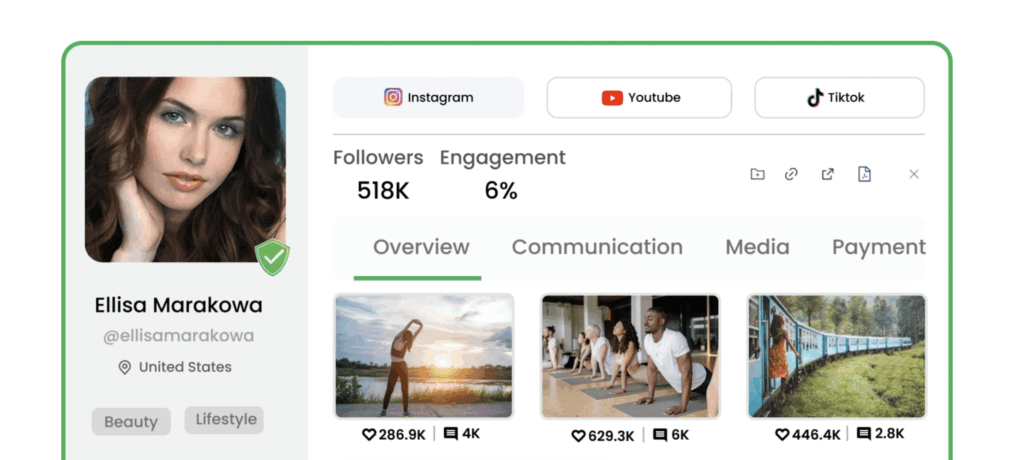
Heepsy is a budget-friendly influencer discovery platform aimed at small businesses and solo marketers. It offers basic search filters, contact info, and engagement metrics, but it stops there. There’s no campaign management, UGC support, or post-campaign tracking.
Compared to Influencity, Heepsy is much simpler and more affordable. It’s great if you just need a list of potential influencers to reach out to manually, but it’s not built for managing relationships or measuring results.
- Content type: Basic influencer posts. No video production or UGC workflows.
- Ideal customer: Small brands, startups, or teams testing influencer outreach.
- Data analysis: Light. Engagement rates, audience size, and niche breakdowns.
- Customization: Very limited, no built-in campaign tools or reporting.
- Creator database size: Good for Instagram. Less depth on TikTok and YouTube.
If you’re just starting out and want a low-cost way to explore influencers, Heepsy works. But for structured campaigns or content production, Influencity, or one of the next few platforms, gives you more to work with.
6. Traackr
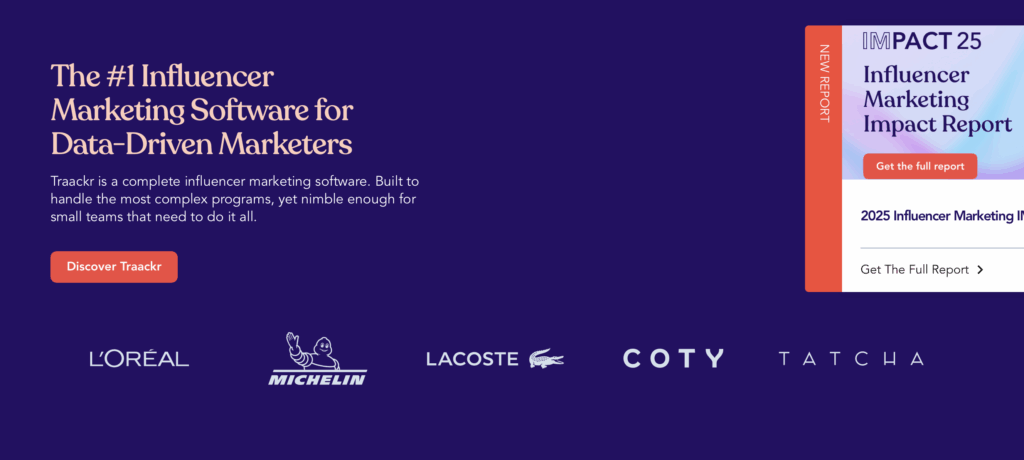
Traackr is built for experienced influencer marketing teams that care about strategy, benchmarking, and long-term performance. It offers deep spend tracking, audience analytics, and brand safety features. If you’re running large-scale programs and need accountability across markets, Traackr delivers.
Unlike Influencity, Traackr is less about day-to-day campaign execution and more about high-level decision-making. There’s no content creation or UGC support, this is strictly a performance and insights platform.
- Content type: Long-term influencer partnerships, benchmarking studies. No UGC production.
- Ideal customer: Global brands and teams with established influencer workflows.
- Data analysis: Excellent. Track ROI, CPM, influencer value, and competitive benchmarks.
- Customization: High. Custom reports and dashboards built for strategy teams.
- Creator database size: Large and vetted, with detailed profile analytics.
If you’re focused on performance metrics and budget oversight, Traackr is strong. But if you’re looking for fast-turnaround creative or short-form UGC, it won’t fill that gap. Influencity offers more campaign tools; other platforms offer more content.
7. Billo
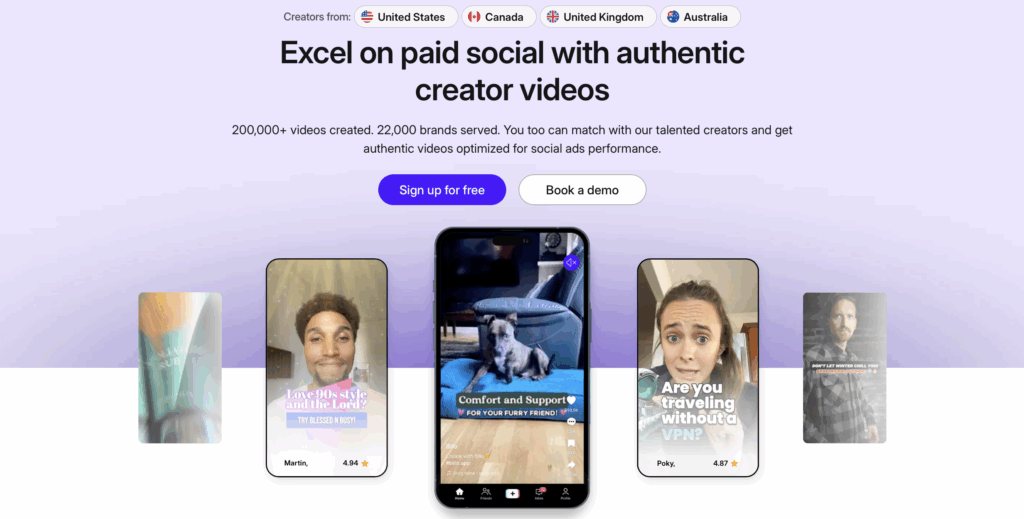
If your priority is launching creator ads that perform, without the hassle of managing influencers, Billo is built for you.
Instead of chasing one-off UGC videos or sponsorship deals, Billo gives you access to the complete Creator Marketing Stack – a data-fed system that predicts, produces, and scales winning ads across TikTok, Meta, YouTube, and beyond.
That’s what makes it fundamentally different from platforms like Influencity. Billo isn’t an influencer management tool – it’s a performance engine for marketing teams who need ad-ready content that’s tested, optimized, and built to scale.
Why brands choose Billo:
- Data-powered briefs & matching – Drop in a product link and instantly get four ad concepts plus a roster of creators proven to deliver results.
- Performance-backed creators – 68% of Billo creators deliver videos that outperform industry medians for ROAS, CTR, or Hook Rate.
- Closed-loop workflow – From briefs to delivery to performance dashboards, everything happens in one place, no DMs or spreadsheets needed.
- Built for scale – Test creative angles fast, then compound the winners into long-term growth.
It’s also worth noting: 84% of people are more likely to trust a brand with UGC in their marketing campaigns, and it shows as UGC increases revenue per visitor by 154%.
Billo is ideal for brands that want scalable, ad-ready UGC videos for business, without the overhead of managing influencers.
If you are ready to start building really powerful UGC-based strategies, we’re here to talk.
FAQs
What’s the main difference between Influencity and its alternatives?
Influencity focuses on influencer relationship management. Some alternatives, like Billo, focus on UGC content creation instead of long-term partnerships.
Is there a platform that does both influencer management and UGC?
Most tools lean one way or the other. If you need both, you might need to combine platforms, one for creators, one for content.
Which alternative is best for ad-ready video content?
Billo is designed for that. You submit a brief, choose your platform, and get short-form videos made for performance marketing.
Are there affordable options for smaller teams?
Yes. Platforms like Heepsy and Modash offer lower-cost entry points. Billo works well for startups that need quick content without long-term contracts.
SEO Lead
Passionate content and search marketer aiming to bring great products front and center. When not hunched over my keyboard, you will find me in a city running a race, cycling or simply enjoying my life with a book in hand.

Authentic creator videos, powered by real performance data
22,000+ brands use Billo to turn UGC into high-ROAS video ads.
Smarter Video Advertising Analytics: 10 Metrics ...
The gap between ad spend and insight is closing – [...]...
Read full articleHow to Create and Execute a UGC Video Marketing ...
Video is one of the most effective ways to connect [...]...
Read full article12 TikTok Video Marketing Trends: What’s Drivi...
Anyone paying attention to the evolution of online content has [...]...
Read full article



